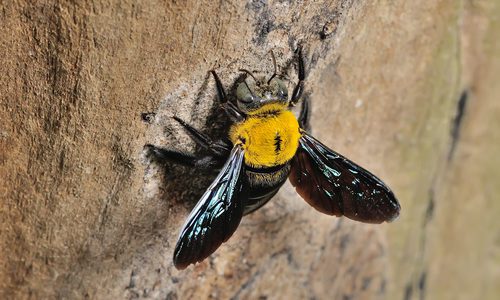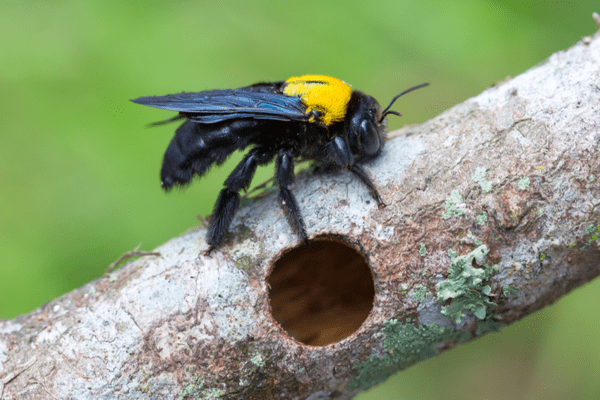
What is a carpenter bee?
Carpenter bees are a variety of bees that bore into wood or other hard plant surfaces. They create tunnels and make nests in these boreholes. Most species in the carpenter bee genus look like a typical bumblebee but are mostly or all-black in their coloring and have shiny abdomens.
There are two well-known varieties of carpenter bees, small and large. When it comes to life and development, both go through complete metamorphosis which means that they start as eggs, then change into grubs, then cocoons, and eventually adults. Carpenter bees are solitary creatures, which means that they don’t organize into colonies like other bees.
The danger of carpenter Bees infestations
Most people worry about bee stings, but only female carpenter bees sting. They don’t often go out of their way to sting unless frightened or provoked. There is nothing especially different about a carpenter bee sting and you should treat it like any other variety of bee sting you may encounter (of course, if allergic, immediate medical attention is necessary).
The main danger carpenter bees pose is the destruction of any wood they encounter. Carpenter bees are bees that bore into wood and prefer unfinished wood surfaces for their nests. This means that if carpenter bees decide to make a nest around your home, you will have a lot of holes, buzzing, and insect trouble to deal with.
What caused my carpenter bee problem?
While it may be easy to assume that carpenter bees eat wood, they don’t. They eat pollen and nectar and consider wood nesting ground. If you have a home with decent amounts of untreated wood like pine, fir, cypress, oak, and redwood, you will likely draw carpenter bees, as those are their favorite varieties.
Like all pests, carpenter bees are attracted to a viable food source. In this case pollen and nectar. If you have an abundance of flowering plants that will provide your bees with a steady food supply along with a safe nesting area, carpenter bees will likely move in.
How can I prevent carpenter bees?
Look for the previously listed varieties of unfinished wood that we’ve mentioned and paint or varnish them to make them less attractive to bees. Common areas carpenter bees like to burrow include:
- Doors
- Windowsills
- Eaves
- Railings
- Decks
- Pergolas
- Lawn furniture.
If you see their boreholes, you can create temporary barriers by filling them with steel wool to block their re-entry. Once you can get a professional pest-removal service to come and permanently clear them out, you can fill the holes permanently. Secure your home against invasion by making sure screens and doors don’t have holes and that any cracks are patched.
Other carpenter bee solutions:
Use natural scents to deter carpenter bees. They dislike the smell of citrus or almond. Mix water and citrus or almond oil extract in a spray bottle and apply around the affected area.
Vibrations may also scare carpenter bees away. Play loud, continuous music in the infested area. They may have second thoughts about sticking around. Make sure you warn your neighbors first.
How can Gregory Pest remove carpenter bees from my home or business?
Gregory’s treatment for carpenter bees begins with a professional inspection of your home or business. During this initial inspection, our licensed technician will accurately identify the variety and location of bees that have made their nests and, in turn, develop a customized treatment plan.
The type of carpenter bee treatment we use will be determined by your technician on-site at the time of inspection. Once they’re eliminated, you as the homeowner can go back to the carpenter bee drill holes and seal and repaint as necessary.

Carpenter Bee FAQ
What do carpenter bees look like?
Carpenter bees aren’t too different than other varieties of bees. They will seem slightly larger and darker in color and have smooth, shiny abdomens unlike fuzzy bumble bees.
What are signs of carpenter bees?
Look for small holes bored into unfinished wood surfaces. Around these areas you may see sawdust and debris along with a yellow substance. Also watch for flight activity and track the pattern to its source.
What does professional bee removal cost?
Prices vary based on the extent of the problem. We want to be sure we eliminate your pest problem completely by providing the best pest control for bees available. Use our request a quote form to get started and get more information about our services.
How do I get rid of carpenter bees permanently?
Using a bee control service followed up with thorough preventative measures will ensure that carpenter bees don’t return to your property. Our technicians can’t help you prep against future infestation once they’ve cleared the current one.
Where can I get help with carpenter bees?
If you live in east-central or the southeastern United States and are currently seeking carpenter bee removal, don’t fret. Gregory Pest Solutions offers our comprehensive residential and commercial pest control services to the states listed below.
Call or contact us using the box below to get started with expert carpenter bee pest control services for your home or business.
